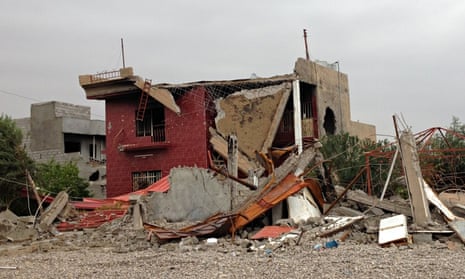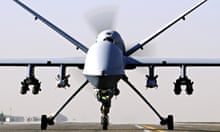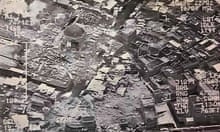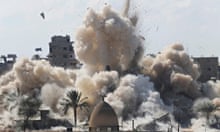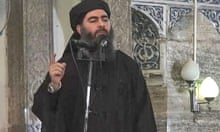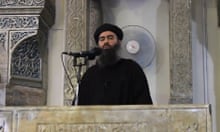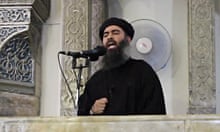In the Iraqi village of Salam, a Shia Muslim volunteer – Muhammad – cheerfully boasted of killing Islamic State (Isis) fighters. “We slaughtered them! Here let me show you,” he said, grabbing a phone from a friend, before playing a gory video with the headless corpses of Isis militants piled on the bonnet of an American Humvee. Blood dripped from the side of the vehicle; Shia militia cheered in the background.
Near to us, smoke billowed from destroyed houses. All of them belonged to Sunni Muslims. In the neighbouring village of Yangija, someone had shot up the Sunni mosque. Footage uploaded onto YouTube at the time – now deleted – showed two men setting light to the corpse of a bloodied Sunni gunman. Now a framed photo of a Shia imam sat on a table outside, decorated with yellow and green Shia militia flags.
Last June Isis overran large chunks of northern and central Iraq in a spectacular military offensive. After arriving in an area the Sunni fighters typcially burned the homes of Shia families. In Salahaddin province, a major flashpoint, thousands of Shias fled.
Last August, however, militias made up of Shia volunteers like Muhammad and backed by Iran began a fightback. They recaptured villages. They gradually shoved out Isis militants. They also enacted a bloody revenge – carrying out their own sectarian massacres in Sunni areas and torching Sunni property.
The mixed Sunni-Shia communities around Tuz Khormato, south of the Kurdish-controlled city of Kirkuk, have borne the brunt of this brutal offensive. In Salam village – ironically enough it means peace in Arabic – Shia militiamen now roam the streets. They have burned down the homes of Sunni inhabitants, all of whom have now fled.
Muhammad and his Shia militia were manning a checkpoint on a road that goes through two Sunni villages to the frontline towards Tikrit. He said he had come from the capital Baghdad to fight Isis.
Much attention has been focused on Isis’s murderous tactics in territories it controls including the northern city of Mosul – beheadings, summary executions, and edicts on women’s dress. But there has been less reporting on the rise of Shia militia groups following the collapse of the regular Iraqi army in early summer. These groups, with the help of Tehran, have flooded the security vacuum. They have mobilised Shia volunteers and – with the support of Kurdish peshmerga forces – have been retaking towns and villages.
According to Amnesty International, Shia militias have abducted and killed scores of Sunni civilians in recent months, and enjoy total impunity for what are “war crimes”. It says the Iraqi government under prime minister Haider al-Abadi has supported and armed the groups, in effect fuelling a new and dangerous cycle of lawlessness and sectarian mayhem.
Scores of unidentified bodies have been discovered across the country. Many are handcuffed and with gunshot wounds to the head, Amnesty says. These execution-style killings have been carried out in apparent revenge for Isis atrocities.
Militia members now number tens of thousands, Amnesty adds. Typically they wear military uniforms but operate without any official control or legal oversight. “By failing to hold militias accountable for war crimes and other gross human rights abuses the Iraqi authorities have effectively granted them free rein to go on the rampage against Sunnis,” Amnesty’s senior crisis response adviser Donatella Rovera said, in a report last month.
Ordinary Iraqis have been caught in the middle of this escalating Sunni-Shia battle. Abu Ammar, a 33-year-old father of two, said he fled the area and now lives in a small rented house in Kirkuk, under the control of the Kurdish regional government, which has its capital in Irbil. “Shia and Sunnis lived side by side in the village. But when Isis took the village they burned the houses of our Shia neighbours. When the Shia militia forced out the Isis militants, they also torched the houses of Sunnis”.
As the Shia militias grow in power, Iran’s military and religious footprint inside Iraq appears to be getting bigger: one prominent militia is the Khorasani Brigade, which openly swears allegiance to Iran’s Supreme Leader, Ayatollah Khamenei.
The group intends to establish an Islamic state like the one in Tehran. It uses an emblem on its yellow flag similar to the ones used by the Iranian Revolutionary Guards and the Hezbollah in Lebanon. A hand firmly holds an AK47, a symbol of resistance.
The brigade’s field commander in the Tuz Khormato area is 30-year-old Juwad al-Husnawi. Husnawi said he had 800 men under his command and had fought alongside Qassem Suleimani – a legendary Iranian general – in both Syria and Iraq. Husnawi recalled an incident when Suleimani personally contacted him in the heat of a recent battle and told him to stand firm until reinforcements turned up.
“The following day he came to the frontline, kissed me on the shoulder and thanked me for holding the line,” Husnawi said. “He is down-to-earth. He will go wherever he is needed. He eats with others and mingles with his fighters. We know him very well and trust him fully.”
Husnawi said he came from a family which had resisted Saddam Hussein. The Baathist regime detained two of his paternal uncles and hanged them in Karbala in 1982 for “anti-government activities”. Husnawi himself is of mixed Iraqi-Iranian parentage and went to school in Iran. His father was active in the opposition against Saddam, which Tehran funded, armed and trained during the Iran-Iraq war in the 1980s.
For men like Husnawi, the fight against Isis isn’t just about freeing the land occupied by radical Sunni jihadists. He said the battle was a Manichean struggle between good and evil, that pits Shias, led by Iran, against the enemies of Islam. When asked who these enemies of Islam were, he replied: “America, Israel, Salafis of Saudi Arabia and the Sunni jihadists.” The group’s long-term goal, he said, was to liberate Palestine and to “remove Israel”.
The Shia militia have developed a reputation for brutality. One Kurdish driver who drives an SUV taking passengers from Irbil to Baghdad said he was more afraid of the Shia militia than the Isis militants when he travels down to the Iraqi capital.
The relationship between Kurdish and Shia forces in the area, meanwhile, is uneasy, even though Iran is the main patron of both parties. Husnawi and a local Kurdish commander speak of friendship, but the two men communicate mainly in sign language.
The day after the Guardian visited Salam village, fighting broke out between the two groups, leading to the death of one Shia militiaman. The Khorasani Brigade temporarily took six peshmarga hostage in revenge.
Ironically, the rise of Isis has led the US and Iran to fight on the same side in Iraq against a common enemy. The White House began its campaign of air strikes against Isis in Syria and Iraq in August. On the ground, Iranian-backed Shia militias and Iranian Revolutionary Guards notched up military successes – for example, freeing the Shia town of Amerli, which Isis besieged for three months. According to Kurdish and Iraqi sources, forces under Iran’s General Suleimani were responsible for breaking the siege.
The Shia militias fought Isis in coordination with the regular Iraqi airforce, sources told the Guardian. According to one senior Iraqi pilot, Iranian pilots fly Iraqi airforce planes regularly. He said the planes taking off from the al-Rashid military base near Baghdad often have one Iraqi Shia and one Iranian pilot. “I have seen it with my own eyes. The Iranians use Sukhoi planes. In some units everyone is Iranian, including the pilot and the mechanics. They use Antonov and Hewi planes to drop barrel bombs on Sunni areas. Some Iranian pilots have been shot down.”
Back in Salam village, several Shia militia fighters said they had previously fought in Syria with Syrian government forces against the country’s rebels. President Bashar al-Assad’s minority Alawite sect is Shia; it is fighting against moderate Syrian opposition as well hardline Isis extremists.
Husnawi explained that he was one of numerous Shia volunteers from Iran, Iraq and Lebanon who had flooded to Damascus to prop up the Assad regime. “My fiancée disagreed with my trip to Syria for jihad. She wanted me to stay in Iraq. I could not stay, so I divorced her before I left,” Husnawi said.
On his second trip, he was wounded near a shrine south of Damascus, he said. He was still recovering from his injury when Isis attacked Mosul in early June. As the battle to break the siege of Amerli loomed, he decided to go to the frontline with his younger brother.
Asked what he would do once the battle was finished, Husnawi said he would return to his civilian life, albeit reluctantly: “To tell you the truth, I don’t want it to be over”.
